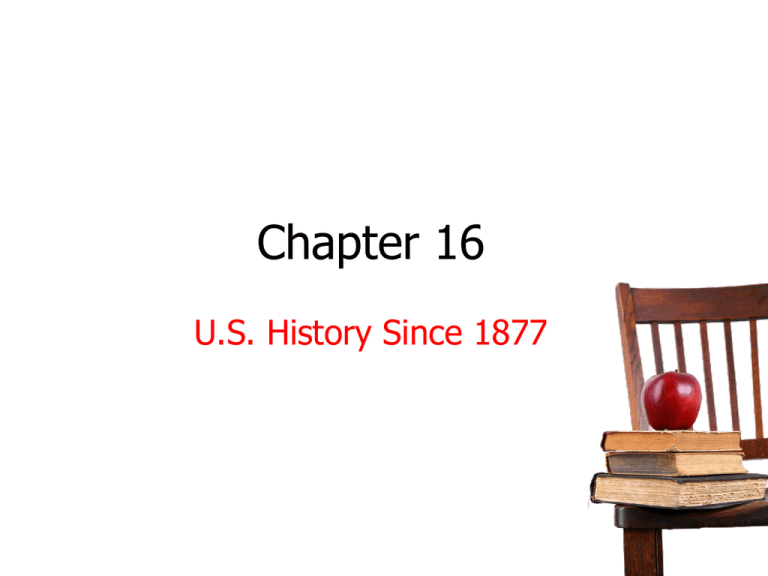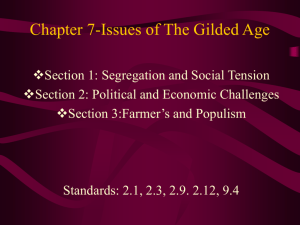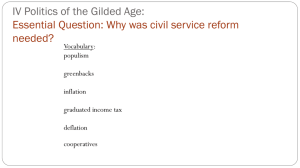Chapter 16
advertisement

Chapter 16 U.S. History Since 1877 Chapter 16 16.1 Stalemate in Washington 16.2 Populism 16.3 The Rise of Segregation Alabama Standards ACOS: 1. Explain the transition of the United States from an agrarian society to an industrial nation prior to World War I. AHSGE Standard V: 2. Evaluate the concepts, developments, and consequences of industrialization and urbanization. 16.1 Stalemate in Washington A Campaign to Clean Up Politics Two Parties, Neck and Neck Democrats Reclaim the White House A President Besieged by Problems Republicans Regain Power A Campaign to Clean Up Politics Under the spoils system, or patronage, government jobs went to supporters of the winning party in an election. Many Americans wanted to reform patronage. President Rutherford B. Hayes attacked the practice of patronage. A Campaign to Clean Up Politics Garfield and Arthur The “Stalwarts” were a group of Republican politicians who opposed civil service reform. They accused Hayes of backing civil service reform to create openings for his own supporters. Civil service reformers were called “Halfbreeds.” President James Garfield was a Halfbreed. A Campaign to Clean Up Politics Vice President Chester Arthur was a Stalwart. Chester Arthur President Garfield was assassinated by Charles J. Guiteau, who wanted a civil service job through the spoils system. http://www.history.com/videos/death-of-president-garfield James Garfield Memorial A Campaign to Clean Up Politics In 1883, Congress passed the Pendleton Act. It allowed the president to decide which federal jobs would be filled according to rules set up by a bipartisan Civil Service Commission. Only people who took the exam could be appointed. Once appointed, a civil service official could not be removed for political reasons. Chester Arthur Two Parties, Neck and Neck Few new policies were introduced in the 1870s and 1880s. The Democrats had control of the House. The Republicans had control of the Senate. Presidential elections were very close. The Republicans won four of the six presidential elections between 1876 and 1896. Democrats Reclaim the White House In the election of 1884, Republicans remained divided over reform. Democrats nominated Governor Grover Cleveland of New York, a reformer who opposed Tammany Hall. Democrats Reclaim the White House Republicans nominated James G. Blaine, a former Speaker of the House. Blaine was popular among Republican Party workers. A major issue was corruption in government. Voters focused on the morals of each candidate. Democrats Reclaim the White House Some Republicans, called “Mugwumps,” disliked Blaine so much that they supported Grover Cleveland. The Mugwumps did not like Blaine’s connection with the Crédit Mobilier scandal. Democrats Reclaim the White House Cleveland admitted to having fathered a child ten years earlier and retained the support of the Mugwumps for his honesty. Blaine tried to persuade Catholics to vote Republican because his mother was a Catholic. His tactic failed. Cleveland was elected president. Ma! Ma! Where’s My Pa! A President Besieged by Problems Many Cleveland supporters sought patronage jobs. Many strikes occurred during Cleveland’s term. Police sometimes attacked the strikers. A bomb exploded at a labor demonstration in Haymarket Square in Chicago. A President Besieged by Problems Only large corporations were given rebates, or partial refunds, and lower rates for shipping goods. In 1886, the Supreme Court ruled in Wabash v. Illinois that Illinois could not restrict the rates charged for traffic between states because only the federal government could regulate interstate commerce. A President Besieged by Problems In 1887, Cleveland signed the Interstate Commerce Act, which created the Interstate Commerce Commission. This was the first law to regulate interstate commerce. Many wanted Congress to cut tariffs because these taxes caused an increase in the price of manufactured goods. A President Besieged by Problems President Cleveland proposed lowering tariffs, but Congress was deadlocked. Tariff reduction became a major issue in the election of 1888. Republicans Regain Power Benjamin Harrison was the Republican candidate in 1888. Industrialist who wanted tariff protection supported Harrison financially. Cleveland ran again and was against high tariff rates. Harrison won the election by winning the electoral vote but not the popular vote. Republicans Regain Power In 1888, Republicans gained control of both houses of Congress and the White House. The McKinley Tariff cut tariff rates on some goods, but increased the rates of others. It lowered federal revenue and left the nation with a budget deficit. A new pension law passed in 1890 for veterans furthered worsened the deficit. The Sherman Antitrust Act of 1890 made trusts illegal, but the courts did little to enforce the law. William McKinley NOTEBOOK Read pages 498-499 in the American Vision. 16.2 POPULISM 16.2 Populism Unrest in Rural America The Farmers’ Alliance The Rise of Populism The Election of 1896 Unrest in Rural America In the 1890s, Populism emerged to increase the political power of farmers. During the Civil War, the government issued greenbacks, or paper currency that could not be exchanged for gold or silver coins. This rapid increase in the money supply resulted in inflation–a decline in the value of money. The prices of goods greatly increased. Unrest in Rural America To fix this, the government stopped printing greenbacks and making silver coins. It also started paying off bonds As a result, the country did not have a large enough money supply to meet the needs of the economy. This led to deflation–or an increase in the value of money and a decrease in the general level of prices. Unrest in Rural America Deflation forced most farmers to borrow money to plant their crops. The short supply of money caused an increase in interest rates that the farmers owed. Some farmers wanted more greenbacks and silver coins. The Grange was a national farm organization that tried to respond to the plight of farmers. Unrest in Rural America Grangers created cooperatives– marketing organizations that worked to help its members. The cooperatives pooled members’ crops and held them off the market to force the prices to rise. Cooperatives could negotiate better shipping rates from railroads. Unrest in Rural America The Grange was unable to improve the economic conditions of farmers. By the late 1870s, many farmers left the Grange and joined other organizations. The Farmers’ Alliance The Farmers’ Alliance was formed in 1877. It organized large cooperatives called exchanges to force farm prices up and make loans to farmers at low interest rates. These exchanges mostly failed because they loaned too much money at low interest rates that were not repaid. A Winston County Farmer The Farmers’ Alliance Other businesses discriminated against the exchanges. Members of the Kansas Alliance formed the People’s Party, or Populists, to push for political reforms. Most Southerners opposed them because most wanted the Democrats to retain control of the South. The Farmers’ Alliance Charles Macune came up with a subtreasury plan. It would set up warehouses where farmers could store their crops to force prices up. The Rise of Populism In 1890 the Farmers’ Alliance issued the Ocala Demands: the adoption of the subtreasury plan the free coinage of silver an end to protective tariffs and national banks tighter regulation of the railroads direct election of senators by voters The Rise of Populism Many pro-Alliance Democrats were elected in the South. By early 1892, Southern members of the Alliance were disappointed by the Democrats. In July 1892, the People’s Party held its first national convention and nominated James B. Weaver for president. James B. Weaver The Rise of Populism The People’s Party platform called for: unlimited coinage of silver federal ownership of railroads a graduated income tax, one that taxes higher earnings more heavily. an eight-hour workday restriction of immigration a ban on the use of strikebreakers. James B. Weaver 1892 The Rise of Populism Democrats nominated Grover Cleveland for the 1892 election. Cleveland won. The Panic of 1893 was caused by the bankruptcy of the Philadelphia and Reading Railroads. It resulted in the stock market crash and the closing of many banks. The Rise of Populism By 1894 the country was in a deep depression. Cleveland wanted to stop the flow of gold and make it the sole basis for the country’s currency. So Congress repealed the Sherman Silver Purchase Act. The Rise of Populism This caused the Democratic Party to split into the goldbugs and the silverites. Goldbugs believed the currency should be based only on gold. Silverites believed coining silver in unlimited amounts was the answer to the nation’s economic crisis. The Election of 1896 The Democrats nominated William Jennings Bryan for the presidential election of 1896. He strongly supported the unlimited coinage of silver. Populists also supported Bryan for president. The Election of 1896 The Republicans nominated William McKinley for president. Most business leaders liked McKinley because they were against unlimited silver coinage. McKinley won. New gold strikes increased the money supply without needing to use silver. As the silver issue died out, so did the Populist Party. Learn more about William Jenning Bryan’s “Cross of Gold Speech” on page 513. 16.3 THE RISE OF SEGREGATION 16.3 The Rise of Segregation Resistance and Repression Disfranchising African Americans Legalizing Segregation The African American Response Resistance and Repression Most African Americans were sharecroppers. They were landless farmers who paid their rent with a large portion of their crops. In 1879 Benjamin “Pap” Singleton organized a mass migration of African Americans, called Exodusters, from the rural South to Kansas. Resistance and Repression Some stayed and formed the Colored Farmers’ National Alliance to help its members set up cooperatives. Many African Americans joined the Populist Party. Democrats began using racism to win back the poor white voters. Disfranchising African Americans Southern states tried to limit almost all African Americans from voting. In 1890 Mississippi required all citizens registering to vote to pay a poll tax. Many African Americans and poor whites could not afford it. Disfranchising African Americans The state also required all prospective voters to pass a literacy test. Most African Americans had no education and failed the test. Other Southern states adopted similar restrictions. Disfranchising African Americans The number of African Americans and poor whites registered to vote fell dramatically in the South. Some Southern states had a grandfather clause to allow poor whites to vote. This clause allowed any man to vote if he had an ancestor on the voting rolls in 1867. Legalizing Segregation African Americans faced discrimination in both the North and the South. In the South, segregation was enforced by laws known as Jim Crow laws. Jim Crow was a character popularized by a slavery-era stage performer. Legalizing Segregation In 1883 the Supreme Court overturned the Civil Rights Act of 1875. This meant that private organizations or businesses were free to practice segregation. Southern states passed laws that enforced segregation in almost all public places. Legalizing Segregation The Supreme Court ruling in Plessy v. Ferguson endorsed “separate but equal” facilities for African Americans. This ruling established the legal basis for discrimination in the South for over 50 years. Between 1890 and 1899, hundreds of southern African Americans were lynched. The African American Response In 1892 Ida B. Wells began a crusade against lynching. She wrote articles and a book denouncing lynchings and mob violence against blacks. The African American Response Booker T. Washington, an educator, urged fellow blacks to achieve economic goals rather than legal or political ones. He explained his views in a speech known as the Atlanta Compromise. The African American Response The Atlanta Compromise was challenged by W.E.B. Du Bois, the leader of African American activists born after the Civil War. Du Bois said that white Southerners continued to take away the civil rights of African Americans, despite progress in education and vocational training. The African American Response He believed that African Americans had to demand their rights, especially voting rights, to gain full equality. AHSGE Practice Compare and contrast the contributions of Washington and Du Bois.





